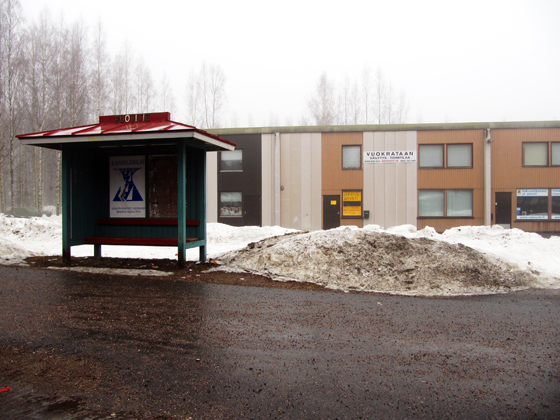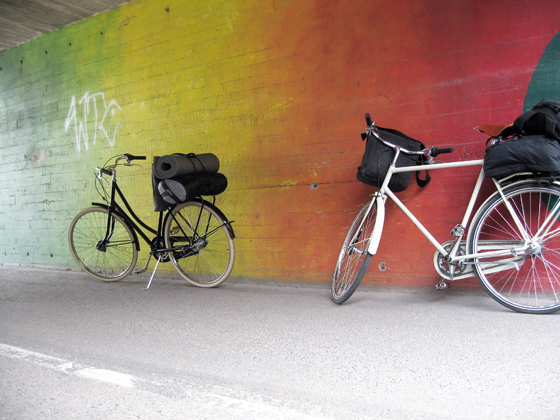
____________________________________________________________________________________
I have spent many childhood summers in my grandfather’s home village in Central Finland. The scenery is picturesque, with a small river running through meadows and forest. But the village itself is rather empty – as is the case today also in many other parts of rural Finland. The most impressive wooden building in the village is gradually deteriorating and the watermills stopped operating already a long time ago. I have only heard stories about the past times, when there was an active community with a local village school and shop.
These days, even the “mobile shop”, a modified bus – the highlight of my summers during the 1980s – has stopped touring the area. The few remaining inhabitants drive to the nearest town 20 kilometres away to do their shopping. Most young people move to bigger cities while the older ones stay behind getting older. Recently, an artist living in the village – in fact my own great aunt – who used to organise summer camps and events, died. The main large-scale event of the summer is probably the Neste Oil Rally.

A similar, melancholic image of the Finnish countryside is familiar to many people. With the exception of the forests populated during the summer by city dwellers with their own summerhouses, the desolate rural towns and villages have been a problematic issue for decades. Finnish cities, most of them not very large to start with, are dividing into two groups. Following a phenomenon common worldwide, some of them are growing and others shrinking. The underlying reasons are similar everywhere: deindustrialisation, migration to the largest cities and in Finland in particular the demographic ageing. (1)
Migration to the larger cities has been going on since the 1950s, when only a third of the Finnish population lived in cities. While university cities –such as the Helsinki metropolitan area, Oulu, Tampere, Turku and Jyväskylä – are growing, the more peripheral industrial towns are having to cope with growing unemployment. (2) In the global context, cities are repositioning themselves: the industrial economy has become the knowledge economy and cities now compete through creativity.

In Finland, like elsewhere, many larger cities have coped with the challenges of deindustrialisation through culture. During the 1980s Detroit, USA, saw the birth of techno, and Manchester, UK, the boom of indie music and nightclubs.(3) In Helsinki, former industrial buildings are being turned into cultural factories – as in the case of the Cable Factory, Suvilahti and Korjaamo – and former harbours into areas of temporary urban subcultures.(4) Also certain smaller towns in relative proximity to Helsinki have a flourishing post-industrial culture, such as the ironworks towns of Fiskars and Billnäs, now populated by artists and craftsmen.
But how, then, should the more peripheral areas in, say, Kainuu or Kymenlaakso reposition themselves and find new strengths, when factory operations are being moved overseas to developing countries?

These areas need new visions and dreams, beyond the ordinary. A project by Demos, the British think tank, introduces an approach to this issue. Their book ‘The Dreaming City – Glasgow 2020 and the Power of Mass Imagination’ (2007) shows how collective and “unofficial” stories were used as a tool to imagine a better future for Glasgow, a city that had previously relied on heavy industries. The idea was to encourage people to create and consider a range of alternative futures in a safe but challenging way, and thus get released from the common assumptions people have about the present. People were involved in the search for stories and dreams through postcards, a website, a short story competition – and a giant wish book.(5)
So why not use this idea and “make a wish” for the shrinking cities in Finland? Let’s turn one common conception on its head and ask whether growth is the only option for positive development. Could shrinking provide a positive opportunity, too? What if we look at the shrinking cities, and say: “What a great opportunity!” There are vast amounts of free and liveable space; a unique chance at the global scale. Even the most remote areas of Finland possess qualities that many other places in the world are lacking: a liveable climate, peace and quiet, and nature not (yet) threatened by earthquakes or hurricanes. In the global world facing rapid population growth, the low-density areas of Finland might become a triumph of tomorrow.

At these times of climate change, it seems clear that we need to create new dynamics and intensity without material growth. This challenge could also be turned into an opportunity. Perhaps the key factor in the revival of shrinking cities lies in finding creative solutions for simple, good quality life with less material resources – an idea that should be applied to any city for that matter.
Alternative strategies to continued economic growth already exist, based on quality rather than quantity. Worldwide, people are looking for remedies to their stressful life and continuous consumption. Slowly also in Finland, locally grown food, organic production, green travel and new local economies of mutual benefit are changing from niche to norm. The rapid success of urban farming, for example, suggests that the urban population wishes to strengthen their relation to nature and combine traditions with contemporary technologies. Rethinking the habits of consuming, eating, travelling and living is about to profoundly change people’s lifestyles.
Following the success of Carl Honorés book ’In Praise of Slowness’, the movement for slow cities is also growing. (6) In Italy, for example, towns such as Orvieto, San Miniato and Todi, have already established themselves officially as “slow cities”. (7) The slow cities have less traffic, less noise and fewer crowds why not look here. They strive with the promise of good living and a simpler lifestyle: enjoying basic things in life, eating well and spending more time with people. Even London has a strategy to challenge the cult of speed: the Slow Down London project aims to inspire Londoners to enjoy their city’s green spaces and architecture, sample slow food and crafts, discover slow travel and get more out of life in their city. (8) Looking at the growing appreciation of slower and greener lifestyles, the Finnish countryside may have a lot to offer. Could it already be on the verge of a positive revival? Can shrinking cities find a new renaissance as places for a meaningful, low-carbon, quality life?
For my own future days in retirement, I have been playing with a thought: to start a small organic farm in my grandfather’s village and renovate the handsome wooden building. Many members of the young urban generation have already chosen alternatives to city life and moved closer to nature in smaller towns. People are buying roadside mills, old railway stations and dairy farms and turning them into homes, cultural stations or shops. There are many undiscovered places still waiting for people’s ideas and dreams to be realised. “The only limits are, as always, those of vision,” like James Broughton once said.
____________________________________________________________________________________

____________________________________________________________________________________
